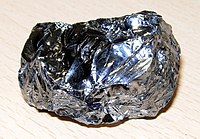
Photo from wikipedia
Abstract The feasibility of preparing oxide layer on a monocrystalline silicon (mc-Si) using the plasma electrolytic oxidation (PEO) process was investigated in this study and the influence of adding boric… Click to show full abstract
Abstract The feasibility of preparing oxide layer on a monocrystalline silicon (mc-Si) using the plasma electrolytic oxidation (PEO) process was investigated in this study and the influence of adding boric acid to the silicate based electrolyte on the formation and the properties of the oxide layer was evaluated. The morphology, chemical composition and phase structure of the layers were characterized by scanning electron microscopy (SEM), energy dispersive spectroscopy (EDS), Fourier transform infrared spectroscopy (FTIR), grazing incidence X-ray diffractometry (GIXRD) and transmission electron microscopy (TEM) techniques. The optical and electrical properties of the grown layers were assessed by ultraviolet–visible spectroscopy (UV–Vis), photoluminescence spectroscopy (PL) and current-voltage measurement methods. The results revealed that an amorphous silicon oxide (SiO2) layer with a crater-like morphology was formed on the mc-Si substrate in the silicate based electrolyte. The addition of boric acid to the electrolyte led to dramatic arcing, stable layer formation conditions, and improved feature quality. The presence of BO33− anions in the electrolyte accelerated the rate of growth, increased the layer surface porosity, and doped the SiO2 structure with boron cations. As a result of these changes, the optical absorbance and photoluminescence emission intensity of the doped oxide layer was enhanced in both ultraviolet and visible regions, as well as the Urbach tail widened, which is declining the band gap energy. In addition, despite the increased surface electrical resistance, the current gain was also increased significantly.
Journal Title: Applied Surface Science
Year Published: 2018
Link to full text (if available)
Share on Social Media: Sign Up to like & get
recommendations!